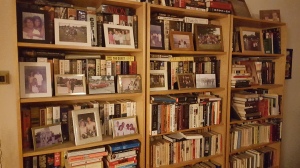During a recent radio interview, I heard someone bemoan all the reading of insignificant detritus he’s done on the Internet, while the good books on his To Read list gather dust: “It’s like I’m on the millionth page of the worst book ever – but I can’t stop reading it.” We’ve all wasted precious time; it’s not the worst sin in the world. But when you find yourself surfing the net and reading about what O.J. Simpson had for breakfast in his prison cell, or about a sighting of Kim Kardashian breast-feeding her baby in public – then you know that some better part of the world is passing you by.
When you start to tally up all the time that gets away, the math is instructive. If you took twenty minutes each day to read good stuff (see below), you’d end up with 120 hours per year. Depending on reading speed and book size, that’s between six to twenty-five books a year. That’s time well spent – directly beneficial to you and indirectly beneficial to those whose paths you cross.
Reading a book is akin to having a conversation with another human being: a deep, meaningful, thought-out exchange that as readers we are able to conduct on our own time. Perhaps a bit grandiose to say, but having a varied and wide reading list is akin to having a conversation with the world. This conversation makes us more aware of our place in the world, and (hopefully) better citizens of it.

Good Stuff: While I do read fiction, I’m admittedly over-balanced on the non-fiction side. Taylor Branch’s Parting the Waters, Dee Brown’s Bury My Heart at Wounded Knee, Paul Johnson’s Modern Times, Richard Rhodes’s The Making of the Atomic Bomb, and Daniel Yergin’s The Prize are but a few of the captivating books I delved into over the years. There are many other books I would add to my A-list: Edmund Morris’s Dutch, Bill Bryson’s A Short History of Nearly Everything, and Jared Diamond’s Guns, Germs, and Steel are but a few others.
While my three kids were in college, they received from their old man a hand-picked bundle of books from the good stuff list. Lucky them! I realized they weren’t going to read these books while in college – they had other books to read and happenings to attend. Yet, like a seed planted in good soil, I trust that this gesture someday will bear beneficial fruit.
Occasionally, Facebook friends will call out for “Top 10” or “Best Ever” reading lists. As we all know, there’s a lot of good stuff out there. It’s eye-opening to see what others are reading; it enlarges the conversation. It’s a blessing to have time to read.
There’s a great difference between information and knowledge. The Internet provides plenty of the former, whereas good books help engender the latter.
I’ll continue to blog on the net, with the purpose of supporting common good development, pointing out the good books along the way that help us get there.
Read on, my friends.
This blog and website are representative of the views expressed in my book Just a Little Bit More: The Culture of Excess and the Fate of the Common Good. JaLBM, distributed by ACTA Publications (Chicago), is available on Amazon as a paperback and an ebook. It’s also available on Nook and iBooks/iTunes, and at the website of Blue Ocotillo Publishing.
If you’re a member of a faith community – Christian, Jewish, Muslim, Buddhist, or other – consider a book study series of Just a Little Bit More. The full-length book (257 pgs.) is intended for engaged readers, whereas the Summary Version and Study Guide (52 pgs.) is intended for readers desiring a quick overview of the work. It also contains discussion questions at the end of all eight chapter summaries.
Readers of both books can join together for study, conversation, and subsequent action in support of the common good.
Let me mention one more great book: Robert Sapolsky’s classic from 1994, Why Zebras Don’t Get Ulcers. Ahem!

